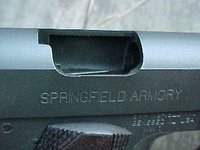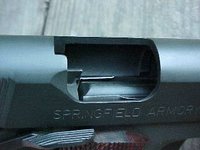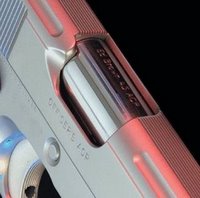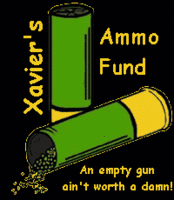1911 Ejection Ports
 In the beginning, there was the GI ejection port, and it was good. The GI type of port is high on the 1911 slide, and ejects reliably. It works well if you don't mind getting smacked in the noggin by brass once in a while. It works well if you do not reload and therefore do not care whether your brass is dented by your slide. The higher port is eschewed by the custom 1911 crowd, but if the truth is told, it serves a purpose. The higher wall helps prevent dirt and grit from getting underneath the barrel into the linking system and potentially jamming the gun. I retained the GI port on my carry 1911s for just that reason. It's not that I don't keep them clean, it's just that I like the extra protection.
In the beginning, there was the GI ejection port, and it was good. The GI type of port is high on the 1911 slide, and ejects reliably. It works well if you don't mind getting smacked in the noggin by brass once in a while. It works well if you do not reload and therefore do not care whether your brass is dented by your slide. The higher port is eschewed by the custom 1911 crowd, but if the truth is told, it serves a purpose. The higher wall helps prevent dirt and grit from getting underneath the barrel into the linking system and potentially jamming the gun. I retained the GI port on my carry 1911s for just that reason. It's not that I don't keep them clean, it's just that I like the extra protection. Later, as 1911s began to be shot competitively, and optics were added, there was a need for the brass to be ejected sideways. People who shot thousands of rounds on a single range trip did not appreciate the intimacy of brass occasionally kissing their foreheads. The port was lowered down the side of the slide, and an extended ejector was added to force the brass in a lateral direction.
Later, as 1911s began to be shot competitively, and optics were added, there was a need for the brass to be ejected sideways. People who shot thousands of rounds on a single range trip did not appreciate the intimacy of brass occasionally kissing their foreheads. The port was lowered down the side of the slide, and an extended ejector was added to force the brass in a lateral direction. Because many competitive shooters reloaded, a scallop cut was added at the rear of the port to prevent the slide from denting the brass. This type of port is often called the flared and lowered port, and it works very well for it's purpose. It is the usual port on off the shelf guns.
 With custom 1911s the ejection port takes on a whole new life. It is often massaged and melted. The forward edge is often tweaked to allow live round ejection through the port (the other ports will do this as well most of the time). Bringing an ejection port to this level of perfection is not the job for a kitchen table gunsmith. Many slides have been ruined by a Bubba with a Dremel.
With custom 1911s the ejection port takes on a whole new life. It is often massaged and melted. The forward edge is often tweaked to allow live round ejection through the port (the other ports will do this as well most of the time). Bringing an ejection port to this level of perfection is not the job for a kitchen table gunsmith. Many slides have been ruined by a Bubba with a Dremel. As usual, a gunsmith will give a customer what he wants. Most customers believe a 1911 must have a hogged out ejection port to function properly. That is simply not the case. The M1911A1 prospered through several major conflicts reliably ejecting brass through a small hole all along the way. It was only when competitive shooters began making demands, and accomodating gunsmiths began tweaking the gun that the port was lowered. Know why the modifications are done to guns. Don't follow fashion. Form should follow function. If you foresee your 1911 being in dirty, gritty conditions, you might want to consider not lowering that hole.
Labels: 1911 Basics





4 Comments:
Thank you. Once again, your pictures really add to the explanation.
What's next in our "Dummies Guide to the 1911"? Hammers, guide rods, that piece that keeps your hand from slipping up into the hammer? Anything special about magazines?
Well, I guess this is as good a place as any to ask a dumb question. Or maybe it's not dumb.
The 1911 has been around in various guises for almost 100 years. It's a well proven design, with a lot of custom variations. I know it's popular, but there would seem to be an ample supply. So, why does it seem that they are all so expensive? I understand that the ones with collector value would garner a premium. I understand that the ones that are highly customized would gather a premium. But what it is about a run of the mill, not so very historic or customized 1911 still seems to command a high price?
I'm sure there's a relatively simple explanation that I've overlooked.
Gary
Gary,
Please do not take this the wrong way, but perhaps you've been looking in the wrong places? I recently purchased an AutoOrdinance AO1911 (mil spec repro) for $480. Springfield Armory sells their mil-spec 1911 for less than that, and Rock Island Arms is even cheaper still.
Even the entry level Smith & Wesson SW1911, which comes well-stocked, sells for ~ $700.
IMHO, under $500 isn't what I'd call expensive for a semi-automatic .45 ACP pistol. The venerable Beretta 92 starts at $500; the only Sig you can touch for under $500 is the Mosquito; even in the world of revolvers $500 is just getting started.
Just my $0.02. YMMV... :)
Jay,
$480 for an AO mil-spec!!?? It got mine brand new from the local Sportsman's Warehouse for a total of $389. Granted, it jammed several times durin it's first range trip, so maybe it wasn't such a good deal....
You're right, though. 1911's aren't always pricey. I heard about a friend of mine who picked up the Norinco 1911 copy for about $300. Nice gun.
Post a Comment
<< Home